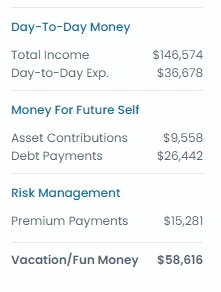Many money ‘gurus’ say that you need to budget, but is it really, truly, worth it?
After all 79% of people that have a budget don’t follow it! In fact, many people have told me budgeting has made their lives worse! The reason is that most do it incorrectly, stress about items that do not matter, and do not know how their choices actually impact their finances.
In this article, I detail how to budget money correctly so you can reduce your stress and know you are doing things right! In short, you don’t have to follow bad advice like the 50-30-20 rule.
The 5 easy steps below will allow to organize your financial life in an easy-to-understand way.
The Budgeting Mistakes Most People Make
Before I dive into the 5 steps to budget your money, I want to discuss 3 mistakes people often make. Understanding these 3 mistakes will help you understand why the 5 steps work…
Mistake #1
People don’t get started. They tell themselves they want to do it but never do, or they do it in their head. You have to sit down and write it out or use money management software. This way you can see everything laid out, have a way to build a financial plan, and hold yourself accountable.
Mistake #2
Most so called “budgeting apps” are just a pretty version of Excel: a big, albeit bucketed, list of income items and expenses. They don’t give you a mental framework to think about money and they don’t provide any insight on where you should be focusing your efforts.
Mistake #3
People think they should budget because they think they are building a financial plan. Then by tracking their budget they believe it’s going to inform them on the progress towards achieving their goals. That is incorrect.
Budgeting simply shows you where your money is going.
Financial planning and tracking your overall plan outlines whether you’re on track to hit your goals. I.e. budgeting is a prerequisite to financial planning and although the two are related, they are not the same thing!
A budget should allow you to do two things: Organize your money and give you an easy way to build a financial plan…. That is it!
The Key To Overcoming These Mistakes & Budgeting Correctly
The first thing you have to do is break up your money into an easy-to-understand framework. You have to have a system that shows you your budget, but also how each dollar you earn is being deployed.
The following steps detail the system that we’ve seen work for over 12,000 young professionals using FitBUX’s technology to manage their money.
How To Budget Money Step 1
Step one is organizing what part of your money is part of your “everyday life”. This breaks down into two easy components: Income and day-to-day expenses.
One key for income is that you want to look at your total (aka gross) income. Total income is your income before items are taken out such as taxes, retirement, etc… People often times only look at net income but that ignores a lot of big items that you need to know and understand so you can better manage your money.
Day-to-day expenses are items like taxes, rent, food, phone bill, water, etc… They DO NOT consists of retirement contributions, debt payments, or insurance premiums. We will come back to those later.
From there you want to subtract the total of your day-to-day expenses from your total income to get to your amount of remaining cash.
To summarize, step 1 covers the items that affect your money and your life on a day-to-day basis.
How To Budget Money Step 2
Step two is where you allocate money towards your investments and debt.
For investments, this could be items such as savings for a short-term goal, 401k, Roth IRA, etc…
For debt, this amount includes your minimum payments plus any extra payments you’d like to make on any outstanding debt.
To summarize, in step 2 we are focusing on money for the long term
How To Budget Money Step 3
Thus far we have covered day-to-day monies and monies allocated for the long-term. However, what happens if something bad occurs and you find yourself without income? What if something happens and I can’t save anymore? These are very real risks to your finances and to your financial plan.
Therefore, in your budget, step 3 is focused on monies you allocate to protecting your finances in case “something bad” happens. Step 3 is focused on the money you will use to pay premiums on different kinds of insurance. Items like car insurance, health care insurance, life insurance, disability insurance, etc…
How To Budget Money Step 4
To summarize up to this point: Step 1 is your day-to-day money, step 2 is money allocated for events that happen over a long period of time, step 3 is money allocated to protecting your financial well-being.
Step 4 takes the remaining cash number you calculated in step 1 and subtracts the money from step 2 and step 3. The result is what we call your “vacation/fun money”: all your expenses are covered, you’re hitting your long-term goals and have the right insurance(s) in place.
If you find yourself in a position where, indeed, your vacation/fun money is > 0 is the amount you’re aiming for, congrats!. You can proceed to step 5.
If, however, you end up with no vacation/fun money or worse, a negative number, you will want to revisit step 1, 2 and 3.
In short, if your vacation/fun money is negative, this means that you are spending more money that you are making… you can’t do that so go back and adjust your budget!

How To Budget Money Step 5
Now that you have your budget you can turn your focus to financial planning. I dive deeper into financial planning in another article so I won’t go into too many details here.
However, this step is where you go back to your budget, make adjustments, if needed, to hit your goals and then you simulate your financial plan.
As you can see, a super detailed budget is minimally important in my opinion. What is important is to make sure that you are taking the steps to follow your broader financial plan.
If you’d like to know why budgeting is important after you’ve completed these five steps then be sure to read that article as well.
Conclusion
In short, a budget should allow you to do two things: Organize your money and give you an easy way to build a financial plan.
Step one of how to budget your money focuses on items happening today, step 2 is over time, and step 3 is protection. Step 4 is checking to make sure you aren’t in a negative cash flow situation each month, and step 5 is moving on to a financial plan.
If you’d like to use a technology that walks you through each of these steps, be sure to check out FitBUX’s free financial plan building technology
By Joseph Reinke, CFA
